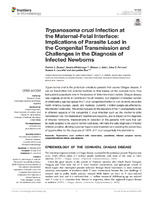Please use this identifier to cite or link to this item:
http://sgc.anlis.gob.ar/handle/123456789/1368| DC Field | Value | Language |
|---|---|---|
| dc.contributor.author | Bustos, Patricia L. | es |
| dc.contributor.author | Milduberger, Natalia | es |
| dc.contributor.author | Volta, Bibiana J. | es |
| dc.contributor.author | Perrone, Alina E. | es |
| dc.contributor.author | Laucella, Susana A. | es |
| dc.contributor.author | Bua, Jacqueline | es |
| dc.date.accessioned | 2019-11-22T20:32:04Z | - |
| dc.date.available | 2019-11-22T20:32:04Z | - |
| dc.date.issued | 2019-06-07 | - |
| dc.identifier.issn | 1664-302X | - |
| dc.identifier.uri | http://sgc.anlis.gob.ar/handle/123456789/1368 | - |
| dc.identifier.uri | https://doi.org/10.3389/fmicb.2019.01250 | - |
| dc.description | Fil: Bustos, Patricia L. ANLIS Dr.C.G.Malbrán. Instituto Nacional de Parasitología; Argentina. | es |
| dc.description | Fil: Milduberger, Natalia. ANLIS Dr.C.G.Malbrán. Instituto Nacional de Parasitología; Argentina. | es |
| dc.description | Fil: Volta, Bibiana J. ANLIS Dr.C.G.Malbrán. Instituto Nacional de Parasitología; Argentina. | es |
| dc.description | Fil: Perrone, Alina E. ANLIS Dr.C.G.Malbrán. Instituto Nacional de Parasitología; Argentina. | es |
| dc.description | Fil: Laucella, Susana A. ANLIS Dr.C.G.Malbrán. Instituto Nacional de Parasitología; Argentina. | es |
| dc.description | Fil: Bua, Jacqueline. ANLIS Dr.C.G.Malbrán. Instituto Nacional de Parasitología; Argentina. | es |
| dc.description.abstract | Trypanosoma cruzi is the protozoan unicellular parasite that causes Chagas disease. It can be transmitted from infected mothers to their babies via the connatal route, thus being able to perpetuate even in the absence of Triatomine insect vectors. Chagas disease was originally endemic in Central and South America, but migration of infected women of childbearing age has spread the T. cruzi congenital infection to non-endemic areas like North America, Europe, Japan, and Australia. Currently, 7 million people are affected by this infection worldwide. This review focuses on the relevance of the T. cruzi parasite levels in different aspects of the congenital T. cruzi infection such as the mother-to-child transmission rate, the maternal and fetal immune response, and its impact on the diagnosis of infected newborns. Improvements in detection of this parasite, with tools that can be easily adapted to be used in remote rural areas, will make the early diagnosis of infected children possible, allowing a prompt trypanocidal treatment and avoiding the current loss of opportunities for the diagnosis of 100% of T. cruzi congenitally infected infants. | es |
| dc.format.mimetype | - | |
| dc.language.iso | en | es |
| dc.publisher | Frontiers Media | es |
| dc.relation.ispartof | Frontiers in microbiology | es |
| dc.rights | Open Access | - |
| dc.rights | Creative Commons Attribution 4.0 International License | - |
| dc.rights.uri | http://creativecommons.org/licenses/by/4.0/ | - |
| dc.source | Frontiers in Immunology 2019; 10:1250. | - |
| dc.subject | Trypanosoma cruzi | es |
| dc.subject | Lactante | es |
| dc.subject | Diagnóstico Precoz | es |
| dc.subject | Mujeres Embarazadas | es |
| dc.subject | Transmisión Vertical de Enfermedad Infecciosa | es |
| dc.subject | Parasitemia | es |
| dc.title | Trypanosoma cruzi Infection at the Maternal-Fetal Interface: Implications of Parasite Load in the Congenital Transmission and Challenges in the Diagnosis of Infected Newborns | es |
| dc.type | Artículo | es |
| dc.identifier.doi | 10.3389/fmicb.2019.01250 | - |
| anlis.essnrd | 1 | - |
| item.languageiso639-1 | en | - |
| item.openairecristype | http://purl.org/coar/resource_type/c_18cf | - |
| item.fulltext | With Fulltext | - |
| item.grantfulltext | open | - |
| item.openairetype | Artículo | - |
| item.cerifentitytype | Publications | - |
| crisitem.author.dept | Instituto Nacional de Parasitología (INP) | - |
| crisitem.author.dept | Administración Nacional de Laboratorios e Institutos de Salud “Dr. Carlos G. Malbrán” (ANLIS) | - |
| crisitem.author.dept | Departamento de Investigación (INP) | - |
| crisitem.author.parentorg | Administración Nacional de Laboratorios e Institutos de Salud “Dr. Carlos G. Malbrán” (ANLIS) | - |
| crisitem.author.parentorg | Instituto Nacional de Parasitología (INP) | - |
| Appears in Collections: | Publicaciones INP | |
Files in This Item:
| File | Description | Size | Format | |
|---|---|---|---|---|
| fmicb-10-01250.pdf | Artículo en inglés | 480.02 kB | Adobe PDF |  View/Open |
Page view(s)
170
checked on Dec 3, 2025
Download(s)
21
checked on Dec 3, 2025
Google ScholarTM
Check
Altmetric
Altmetric
This item is licensed under a Creative Commons License


